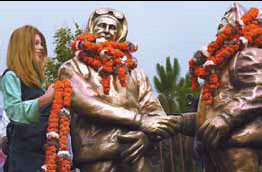Nepal celebrates pioneering climbers
|
Amelia Rose Hillary, granddaughter of New Zealand mountaineer Edmund Hillary, lays garlands on the statues of Tenzing Norgay and Hillary during the Qomolangma Diamond Jubilee celebrations in Kathmandu on Wednesday. Prakash Mathema / Agence France-Presse |
Nepal marked the 60th anniversary of the first ascent of Qomolangma, also known as Mount Everest in the West, on Wednesday, celebrating the pioneering climbers whose bravery spawned an industry that many mountaineers fear is now ruining the world's highest peak.
Four days of ceremonies were concluded on Wednesday, with family members of Edmund Hillary and Tenzing Norgay, the first people to reach the summit, laying garlands on statues of the now legendary pair.
Hillary's granddaughter and niece joined Italian climbing celebrity Reinhold Messner, Tenzing's grandson Tashi Tenzing and the last surviving member of the 1953 expedition, Kancha Sherpa, in a horse-drawn chariot procession through Kathmandu.
The British-funded trip to the highest point on earth - 8,848 meters above sea level - changed mountaineering forever and turned New Zealander Hillary and Nepalese guide Tenzing into household names in many parts of the world.
'Rock stars'
"Hillary and Tenzing were rock stars of the 1950s and into the 1960s," said Hillary's son Peter. "The biggest thing about 1953 is that they were going into the unknown.
"People didn't know what was up there, they didn't know whether or not you could remain conscious, they didn't know whether they could climb that final knife-edged ridge and get up what is now called the Hillary Step."
A host of famous mountaineering figures attended a gala on Wednesday night at the palace of Nepal's former royal family in the capital.
But while the Nepalese government is keen to promote the anniversary - Qomolangma is a key revenue earner for the impoverished country - many in the climbing community reflected on the dangers of over-commercialization.
Recent photographs showing queues of climbers waiting their turn to reach the summit, as well as gathering mounds of rubbish and even a brawl between climbers and porters this year, have highlighted problems on the "roof of the world".
Playground
Qomolangma has turned into a playground for people with all sorts of interests, said veteran climber Temba Tsheri Sherpa, who now runs an expedition company.
"All they want is to set new records and they seem to be willing to pay thousands of dollars in order to fulfill their dreams," he said.
More than 4,400 people have so far reached the peak, according to government figures.
This season alone 540 people made it to the summit, including a Japanese octogenarian, the first female amputee, the first women from Saudi Arabia and Pakistan, and the first armless man.
Kancha Sherpa, now 81, worked as a porter on the maiden expedition, which he remembers as an arduous but ultimately joyous affair - although he regrets that the glory is not more equally shared among the team.
Kancha said that although "everyone knew" Tenzing and Hillary climbed Qomolangma, "nobody knows how hard we worked along the way".
He added that 1,200 porters were gathered at Bhaktapur near Kathmandu.
"Everyone walked from there because there weren't any roads, no motor vehicles, no planes. It took us 16 days to reach Namche," he added.
Namche is today the start of the Qomolangma route.



















